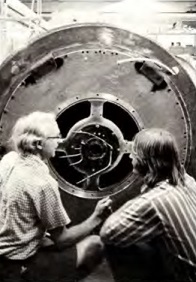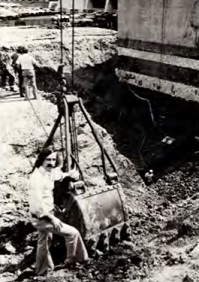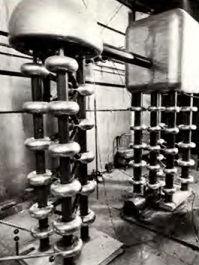New Ion Source Coming for Accelerator
An important modification of the Fermilab accelerator is underway in the construction now going on at the north end of the linear accelerator building. The two-fold project includes installation of a second pre-accelerator (the "Cockcroft-Walton") as well as an addition to the linear accelerator building to provide new space for about 45 Accelerator Division personnel.
"The purpose of the new pre-accelerator is to end up with higher intensity for the high energy physics program," according to Curt Owen, head of the Linac Group. The preaccelerator is the first of the four stages of acceleration in the Fermilab accelerator system. It is the source of the protons that form the beam used by experimenters. The new Cockcroft-Walton will accelerate negative hydrogen ions through the linac for injection into the Booster Accelerator. (The present Cockcroft-Walton generates positive ion, protons.) At the point of injection into the Booster the negative ions will strike a thin foil, removing the electrons and leaving protons for the Booster to accelerate.
The new installation utilizes a Cockcroft-Walton purchased by the Laboratory some years ago as a spare. It has been in operation in the Village for about a year as a test stand.
In the course of the continuing program to reach an intensity of 5 x 1013 protons per pulse in the main accelerator, this new mode has been developed by the Accelerator Division. For a number of very complicated technical reasons, this major step is seen as another important step toward the intensity goal. "It should be possible to produce a higher quality beam for the Booster, giving us more efficient operation at our present intensities and ultimately giving us higher intensities in the Main Ring," Owen states.
The additional work space for the Accelerator Division will permit electrical and electronic personnel of the Accelerator Division to work closer to the accelerator.
The construction project, expected to take about 11 months, is under the direction of Architectural Services. Jim Filliung is the Project Engineer. Several months will be necessary to bring the new generator into operation. Tests will begin in the summer of 1977.






